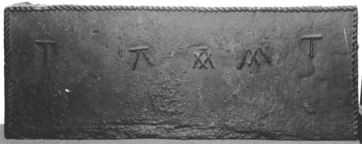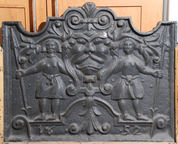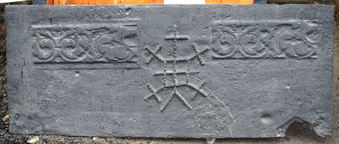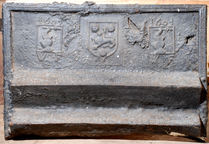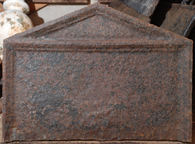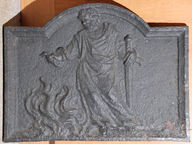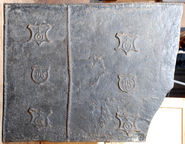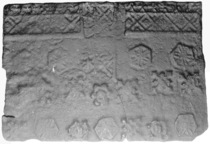-
169
Description: Rectangular; twisted rope edging (top and sides); inscription made of short lengths of twisted rope, irregularly spaced across upper middle, central device formed of a Tudor 'A' with overstamped 'V'.
Notes: It is not clear if the central device is a monogram, or if it might have apotropaic significance.
Inscription: T A M T
- Decoration tags:
- rectangular (shape)
- rope (edging)
- simple stamps
- apotropaic
- text
- objects
Manufactured: in the early- to mid-16th century in the Weald area of England.
Current location: Hastings Museum and Art Gallery, John's Place, Bohemia Road, Hastings, East Sussex, England.
Museum number: HASMG: 1911.60.7 (part of the Hastings Museum museum group)
Citation: Page, S. & Wallace, M. (eds.), 2018, Spellbound (Oxford, Ashmolean Museum), p. 72.
- Attached to series:
- Rope design firebacks
-
171
Description: Quasi-rectangular with raised symmetrical scrolls between semi-circular re-entrants on top edge; ovolo-moulded edge on bottom and sides, with fillet edging on top; grotesque face with swirled hair locks, above an inverted floral spike, between two moustachioed male figures in tunics, holding pikes, standing on a cavetto-moulded compartment, date beneath.
Notes: Alleged to represent the 'Brede Ogre', Sir Goddard Oxenbridge (1478-1531) who, legend states, was sawn in half by local children. Stylistically similar to other firebacks with connections with Brede furnace.
Copies of this fireback are known.
Inscription: 16 52
- Decoration tags:
- rectangular with ornate arch (shape)
- fillet (edging)
- whole carved pattern
- individual numbers
- pictorial
- text
- humans
Manufactured: in 1652 probably at Brede Furnace in the Weald area of England.
Current location: Hastings Museum and Art Gallery, John's Place, Bohemia Road, Hastings, East Sussex, England.
Museum number: HASMG: 1924.42 (part of the Hastings Museum museum group)
Citation: Baines, J. M., 1958, Wealden Firebacks (Hastings Museum).
Citation: Butterfield, W. R., 10 Mar 1934, 'The Brede Ogre', Hastings and St Leonards Observer.
- Attached to series:
- Hooked '1' series
- Brede group
-
173
Description: Rectangular; twisted rope edging (top, and top two-thirds of sides); rectangular stamp with griffin passant, repeated six times: two in top corners; two in bottom corners, rotated left; two in middle, separated by two inverted shields bearing a rose and crown, placed vertically; across each top corner, a length of twisted rope.
Notes: Five other firebacks bearing these stamps are known: one is also in Hastings, and one, dated 1569, is at Hadlow Down, Sussex. The locations of the other three are not known.
- Decoration tags:
- rectangular (shape)
- rope (edging)
- simple stamps
- carved stamps
- heraldic
- objects
Manufactured: in the mid- to late-16th century in the Weald area of England.
Current location: Hastings Museum and Art Gallery, John's Place, Bohemia Road, Hastings, East Sussex, England.
Museum number: HASMG: 1909.78 (part of the Hastings Museum museum group)
Citation: Baines, J. M., 1958, Wealden Firebacks (Hastings Museum).
- Attached to series:
- Griffin series
-
174
Description: Rectangular; plain plate with central crossed-square rope pattern with crosses at the corner and top; on each side a rectangular stamp with swirled tendril, serpent and demi-cup decoration.
Notes: The crossed square was an alchemistic symbol for iron vitriol (i.e. ferrous sulphate or copperas), but the crosses at the extremities may indicate other symbolism or none; similar patterns are found on other firebacks of a group that may have been associated with Pounsley furnace, Sussex. The repeated panel at the top appears to have been formed using a mould for a section of a plasterwork frieze, resulting in an intaglio impression (approx 395 x 142mm or 15½ x 5½ in.) as opposed to the normal bas-relief; this is very unusual on a fireback. The style of the mould dates from the Elizabethan or Jacobean period. The stubs on the bottom edge are likely to have been the remains of runners where the molten iron entered the mould. Recovered from a property in Burwash, Sussex, in 1910.
- Decoration tags:
- rectangular (shape)
- none (edging)
- simple stamps
- apotropaic
- animals
- objects
Manufactured: in the late-16th to early-17th century possibly at Pounsley Furnace, Framfield in the Weald area of England.
Current location: Hastings Museum and Art Gallery, John's Place, Bohemia Road, Hastings, East Sussex, England.
Museum number: HASMG: 1910.26.1 (part of the Hastings Museum museum group)
Citation: Baines, J. M., 1958, Wealden Firebacks (Hastings Museum).
- Attached to series:
- Pounsley series
- Miscellaneous stamp firebacks
-
178
Description: Arched; cavetto edging; crowned plain shield bearing a Tudor rose, with crowned lion and dragon supporters, with garter and motto; date split by crown.
Notes: A much-copied fireback; the numerals are uncharacteristically modern in form, suggesting they have been substituted on a later copy; a variant illustrated by Dawson (no. 269) shows a cross above the crown and more typically 16th century numerals. Formerly part of the Ade Collection (from Grove Hill, Hellingly, Sussex).
Copies of this fireback are known.
Inscription: 1571 HONI SOIT... ...DROI ? K
- Decoration tags:
- rounded arched (shape)
- fillet (edging)
- whole carved pattern
- individual numbers
- heraldic
- royal
- text
Manufactured: in the late-19th to early-20th century possibly in the Weald area of England.
Current location: Hastings Museum and Art Gallery, John's Place, Bohemia Road, Hastings, East Sussex, England.
Museum number: HASMG: 1952.51.45 (part of the Hastings Museum museum group)
- Attached to series:
- Miscellaneous royal firebacks
-
179
Description: Rectangular; double fillet moulded edging; top centre, on a rectangular block, shield of the arms of the Fowle family - (Gules) a lion passant guardant between three roses (Or); on each side, two rectangles, each containing a helm and the crest of the Fowles - an Arm in armour holding a Battle axe issuant from a Ducal Coronet, above each being the date, 1603, and below each the initials, WF. Across the lower half of the fireback are two solid triangular prisms of iron.
Notes: The stamps relate to William Fowle (1568-1634), ironmaster of Riverhall furnace. The shield stamp also appears on grave slabs in Wadhurst and Frant churches and on an unprovenanced graveslab in Maidstone Museum. The iron prisms were included, perhaps, to retain heat and to prevent the fireback from cracking. Formerly part of the Ade Collection (from Grove Hill, Hellingly, Sussex).
Inscription: 1603 WF [twice]
Arms: William Fowle, of Frant and Wadhurst
- Decoration tags:
- rectangular (shape)
- double fillet (edging)
- carved stamps
- heraldic
- armorial
- text
Manufactured: in 1603 probably at Riverhall Furnace, Wadhurst in the Weald area of England.
Current location: Hastings Museum and Art Gallery, John's Place, Bohemia Road, Hastings, East Sussex, England.
Museum number: HASMG: 1952.51.59 (part of the Hastings Museum museum group)
- Attached to series:
- Fowle series
-
186
Description: Plain rectangle with cavetto moulded edging (top and sides); pediment with same moulding.
Notes: Three identical backs, but with various stamps, indicate that the pattern for this fireback formed the base board for them and came from the same source as a distinct series of Tudor heraldic backs. Formerly part of the Ade Collection (from Grove Hill, Hellingly, Sussex).
- Decoration tags:
- triangular arched (shape)
- cavetto (edging)
Manufactured: in the mid- to late-16th century in the Weald area of England.
Current location: Hastings Museum and Art Gallery, John's Place, Bohemia Road, Hastings, East Sussex, England.
Museum number: HASMG: 1952.51.47 (part of the Hastings Museum museum group)
- Attached to series:
- Royal series
- Base boards
- Royal (wreath) series
-
162
Description: Arched rectangular shaped; cavetto-moulded edge; figure of St Paul, a sword in his left hand, holding a viper in his right hand over flames rising from the ground.
Notes: The scene illustrates an episode in the New Testament, Acts 28: 3. The design shows stylistic similarities to other firebacks where simple, well-executed relief has overlapped the cavetto edging. Formerly part of the Ade Collection (from Grove Hill, Hellingly, Sussex).
Copies of this fireback are known.
- Decoration tags:
- rectangular with round arch (shape)
- cavetto (edging)
- whole carved pattern
- pictorial
- biblical
- humans
Manufactured: in the mid- to late-17th century possibly in the Weald area of England.
Current location: Hastings Museum and Art Gallery, John's Place, Bohemia Road, Hastings, East Sussex, England.
Museum number: HASMG: 1952.51.25 (part of the Hastings Museum museum group)
Citation: Butterfield, W. R., 1916, 'Old Wealden Firebacks', The Connoisseur, 46, pp. 197-209.
- Attached to series:
- Small cavetto series
- New Testament firebacks
-
176
Description: Probably originally rectangular; twisted rope edging (top and sides); two (originally probably three) panels divided by vertical twisted rope, each containing a rounded shield with fillet edge with 'ihs' (the 'h' crossed), between two cartouche-style shields with fillet edge, bearing a cross rising from two concentric rings.
Notes: The overtly religious symbolism may indicate a pre-Reformation or Marian date. The christogram, 'ihs', derived from the first three letters of 'IESUS' in Greek, was first noted in England in the 14th century. The cross rising from the rings may be intended to indicate christian dominion over the globe. Possibly as much as the right third of the fireback is missing. The fireback is believed to have been in Robertsbridge Abbey.
Inscription: ihs ihs
- Decoration tags:
- rectangular (shape)
- rope (edging)
- simple stamps
- carved stamps
- heraldic
- text
Manufactured: in the early-16th century possibly in the Weald area of England.
Current location: Hastings Museum and Art Gallery, John's Place, Bohemia Road, h, East Sussex, England.
Museum number: HASMG: 1914.38 (part of the Hastings Museum museum group)
- Attached to series:
- Religious firebacks
-
152
Description: Rectangular; plain plate; on top, twice repeated stamp probably formed of a section of cresting with a row of seven ?fleurs-de-lys above a diagonal grid of squares, each with a small raised square in the middle, and a horizontal astragal border below; between the cresting, a stamp of indeterminate form and design; below, four repeated hexagonal stamps, each divided into triangles by raised lines, two under each cresting stamp; between them, a stamp of indeterminate form and design, possibly the same as the one above it; below, probably six double crosses flory, with a flower head stamp between each group of three; along the bottom, two crosses flory, three hexagon stamps and two other stamps of indeterminate form and design (though different from those described above), arranged asymetrically.
Notes: A crude and poorly executed casting. Butterfield (1916) illustrated this fireback the other way up, and that is how it was displayed in Hastings Museum when it was photographed in the early 2000s. The orientation of this fireback has been reconsidered and the greater relative wear and heat corrosion of the smaller individual stamps suggests that the cresting was originally at the top of the fireback and not the bottom.
- Decoration tags:
- rectangular (shape)
- none (edging)
- carved stamps
- objects
Manufactured: in the mid-16th century in the Weald area of England.
Current location: Hastings Museum and Art Gallery, John's Place, Bohemia Road, Hastings, East Sussex, England.
Museum number: HASMG: 1911.60.8 (part of the Hastings Museum museum group)
Citation: Butterfield, W. R., 1916, 'Old Wealden Firebacks', The Connoisseur, 46, pp. 197-209.
- Attached to series:
- Miscellaneous stamp firebacks
